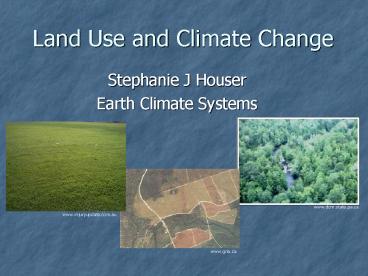Land Use and Climate Change - PowerPoint PPT Presentation
Title:
Land Use and Climate Change
Description:
Land Use and Climate Change Stephanie J Houser Earth Climate Systems www.dcnr.state.pa.us www.injuryupdate.com.au www.gnb.ca – PowerPoint PPT presentation
Number of Views:303
Avg rating:3.0/5.0
Title: Land Use and Climate Change
1
Land Use and Climate Change
- Stephanie J Houser
- Earth Climate Systems
www.dcnr.state.pa.us
www.injuryupdate.com.au
www.gnb.ca
2
Outline
- Why be concerned with land cover/land use change
- How do different land cover/land use changes
affect climate - Climate model studies
- DOE-PCM A2 B1 IPCC SRES (Feddema et al., 2005)
- CLM3 coupled model (Gibbard et al., 2005)
- Summary of findings
3
Why?
- Changes in land cover/use are major but poorly
recognized drivers of long-term global climate
patterns - May be as important as changes in climate and
weather associated with greenhouse gases - Changes often permanent
- IPCC has yet to include effect in assessments
Pielke 2005
4
How do land cover/land use changes affect climate?
- Impacts on global climate divided into two major
categories - Biogeochemical and Biogeophysical
- Biogeochemical
- Chemical composition of the atmosphere
- Biogeophysical
- Directly affect physical parameters that
determine absorption/distribution of energy at
the earths sfc - Albedo
5
How do these changes affect climate?
- Deforestation
- Warming due to decreased evapotranspiration
- Modification of surface fluxes of heat and water
vapor - Reforestation
- lowering of sfc albedo leads to a net warming
- Increase sfc fluxes of water vapor
- Cooling with vegetation at lower latitudes due to
evapotranspiration
www.greenpeace.org
www.auroville.org
6
Climate model studies
- Fully coupled Department of Energy Parallel
Climate Model (DOE-PCM) - Combined land-cover and atmospheric forcings for
A2 and B1 IPCC SRES scenarios - Land cover change Integrated Model to Assess
the Global Environment (IMAGE) IPCC SRES
land-cover projections and DOE-PCM natural
vegetation data - For each SRES scenario, ran model from
- 2000 to 2033 with present day land cover
- 2033 to 2066 with 2050 land cover
- 2066 to 2100 with 2100 land cover
- (Feddema et al, 2005)
7
Feddema et al, 2005
8
fd
- Temperature change
- All forcing scenario minus atmospheric forcing
with constant land cover - Most significant regional climate effects are
associated with changes in mid-latitude and
tropical regions
Feddema et al, 2005
- Tropical regions with same land cover forcings
have different responses - Amazon warming due to change from broadleaf
forest to agriculture - Net radiation changes in atm forcing scenarios
offset by increases in latent heat fluxes when
forests are present - Land-cover and atm forcing simulations, reduced
latent heat flux, increased incident radiation - Indonesia - lack of response attributed to Asian
Monsoon circulation which override feebacks from
local land-cover change
9
Feddema et al, 2005
- Diurnal Temperature Range
- More significant impact
- Decreases significantly in southern Asia
- (A2) Midlatitide regions experience decrease in
DTR - In the Amazon, significant increase in daily
minimum temperatures (nighttime)
10
Climate model studies
- Not reproducing observed patterns of land cover
change, nor realistically simulating possible
future scenarios - CAM3 (Community Atmosphere Model)
- Coupled with the CLM land model and slab ocean
and thermo sea ice model - Control runs with both current vegetation and
bare soil - Two vegetated experiments, one with trees, and
one with grass/shrubs. - (Gibbard et al., 2005)
11
- Temperature difference between the tree
simulation and bare soil simulation - Heating effects of forest in upper latitudes
- Albedo-change dominates over evapotranspiration
- b. Vegetation from 20-50N replaced by forest,
rest of vegetation current - - Direct effect of trees is warming (more
than with bare ground) - c. Albedo change (bare vs. tree)
- - Snow-albedo feedback effect responsible
for 25 of change in sfc albedo between bare and
tree simulations - - Max albedo change in North where snowfall
has decreased due to increased temperatures
12
Summary
- Changes in Land cover and Land use induce changes
in climate on regional and global scales - Albedo-change and evapotranspiration effects
dominate cooling/warming of climate - Overall warming due to reforestation (higher
latitudes) - Forestation causes cooling in Amazon, whereas
deforestation seems to cause warming - Evapotranspiration effects dominate at lower lats
- Future research is needed to determine exact
nature of responses due to land use and land
cover change (Feddema et al., 2005) - In order for IPCC to more accurately predict
future climates the effects of Land cover change
and land use change must be included in future
assessments
13
Questions?































